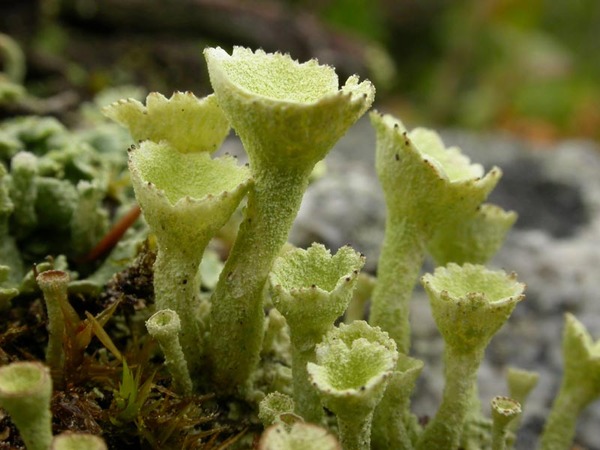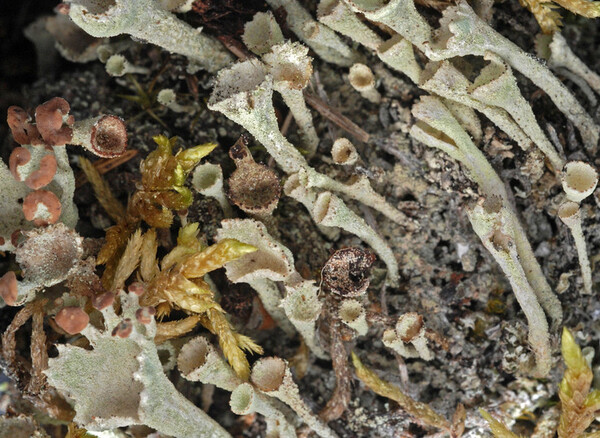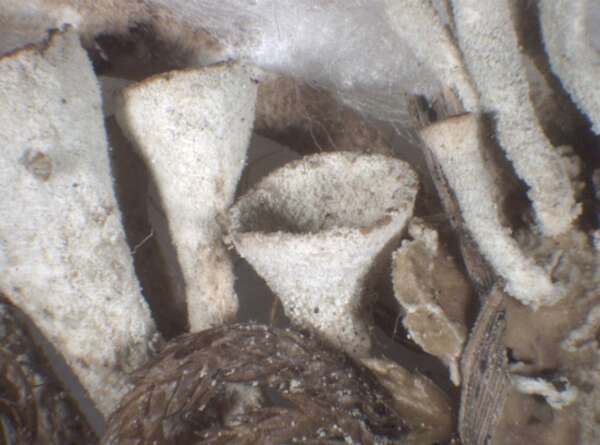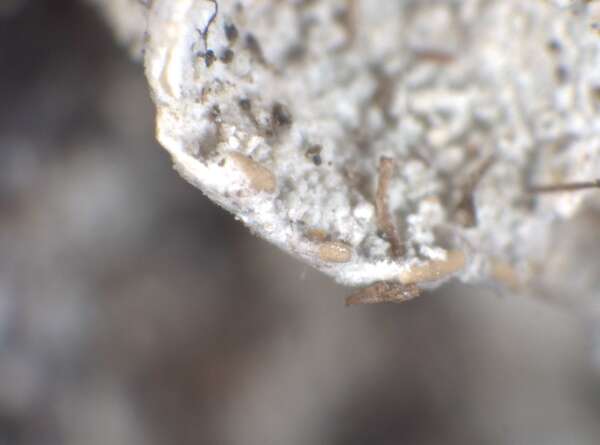Cladonia carneola (Fr.) Fr.
Lichenogr. Eur. Ref.: 233, 1831. Basionym: Cenomyce carneola Fr. - Sched. Crit. Lich. Suec., 3-4: 23, 1825.
Synonyms:
Description: Primary thallus squamulose, the squamules persistent or usually disappearing, small and often inconspicuous, 1-3(-4) mm long and wide, rounded at apices, yellowish-greyish-green above, white to yellowish beneath, darkening towards the base. Podetia hollow inside, yellowish-greyish-green, not melanotic at base, usually esquamulose or with a few squamules the base, 0.5-3(-5) cm tall, entirely farinose-sorediate (soredia 20-40 μm in diam.), with regular, up to 7 mm wide cups abruptly tapering to a 0.2-2 mm thick stalk, the margins of cups often toothed, sometimes proliferating. Apothecia not very frequent, located on the margins of cups, waxy yellow to very pale brown, convex and stipitate. Asci 8-spored, clavate, thickened at apex, with a K/I+ blue tholus and a K/I+ strongly blue outer gelatinous sheath, Cladonia-type. Ascospores 1-celled, hyaline, ellipsoid. Pycnidia frequent on the marginal teeth of cups, pale brown, with a colourless jelly. Conidia hyaline, curved. Photobiont chlorococcoid. Spot tests: K-, C-, KC+ yellowish, P-, UV-. Chemistry: usnic acid, zeorin (the latter visible as a layer of crystals on the surface, especially in herbarium specimens), rarely with additional barbatic acid.
Growth form: Fruticose
Photobiont: green algae other than Trentepohlia
Reproductive strategy: mainly asexual, by soredia, or soredia-like structures (e.g. blastidia)
Commonnes-rarity: (info)
Alpine belt: rather rare
Subalpine belt: rather common
Montane belt: very rare
Dry submediterranean belt: absent
Humid submediterranean belt: absent
Padanian area: absent
pH of the substrata:
1 2 3 4 5
Solar irradiation:
1 2 3 4 5
Aridity:
1 2 3 4 5
Eutrophication:
1 2 3 4 5
Poleotolerance:
0 1 2 3
Altitudinal distribution:
1 2 3 4 5 6
Rarity
absent
extremely rare
very rare
rare
rather rare
rather common
common
very common
extremely common
Loading data...
Occurrence data
Predictive map
Growth form: Fruticose
Photobiont: green algae other than Trentepohlia
Reproductive strategy: mainly asexual, by soredia, or soredia-like structures (e.g. blastidia)
Commonnes-rarity: (info)
Alpine belt: rather rare
Subalpine belt: rather common
Montane belt: very rare
Dry submediterranean belt: absent
Humid submediterranean belt: absent
Padanian area: absent
pH of the substrata:
| 1 | 2 | 3 | 4 | 5 |
Solar irradiation:
| 1 | 2 | 3 | 4 | 5 |
Aridity:
| 1 | 2 | 3 | 4 | 5 |
Eutrophication:
| 1 | 2 | 3 | 4 | 5 |
Poleotolerance:
| 0 | 1 | 2 | 3 |
Altitudinal distribution:
| 1 | 2 | 3 | 4 | 5 | 6 |
Rarity
absent
extremely rare
very rare
rare
rather rare
rather common
common
very common
extremely common
Loading data...
Occurrence data
Predictive map













